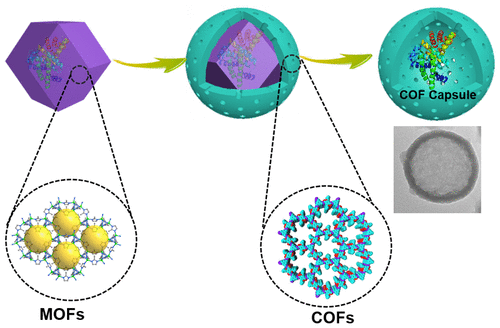当前位置:
X-MOL 学术
›
J. Am. Chem. Soc.
›
论文详情
Our official English website, www.x-mol.net, welcomes your feedback! (Note: you will need to create a separate account there.)
Fabricate Covalent Organic Framework Capsules with Commodious Microenvironment for Enzymes
Journal of the American Chemical Society ( IF 15.0 ) Pub Date : 2020-03-20 , DOI: 10.1021/jacs.0c00285 Mingmin Li 1 , Shan Qiao 1 , Yunlong Zheng 1 , Yassin H. Andaloussi 2 , Xia Li 2 , Zhenjie Zhang 2, 3 , Ang Li 1 , Peng Cheng 3 , Shengqian Ma 4 , Yao Chen 1
Journal of the American Chemical Society ( IF 15.0 ) Pub Date : 2020-03-20 , DOI: 10.1021/jacs.0c00285 Mingmin Li 1 , Shan Qiao 1 , Yunlong Zheng 1 , Yassin H. Andaloussi 2 , Xia Li 2 , Zhenjie Zhang 2, 3 , Ang Li 1 , Peng Cheng 3 , Shengqian Ma 4 , Yao Chen 1
Affiliation

|
Enzyme immobilization has demonstrated itself to be a favorable protocol to promote industrialization of biomacromolecules. Despite tremendous efforts to develop new strategies and materials to realize this process, maintaining enzyme activity is still of formidable challenge. Herein, we created a sacrificial templating method, using metal-organic frameworks (MOFs) as sacrificial templates to construct hollow covalent organic framework (COF) capsules for enzyme encapsulation. This strategy can provide capacious microenvironment to unleash enzyme molecules. The improved conformational freedom of enzymes, enhanced mass transfer and protective effect against external environment ultimately boosted the enzymatic activities. We also found that this strategy possesses high versatility that is suitable for diverse biomacromolecules, MOF templates and COF capsules. Moreover, the dimensions, pore sizes and shell thickness of COF capsules can be conveniently tuned, allowing for customizing bioreactors for specific functions. For example, co-encapsulation of different enzymes with synergistic functions were successfully demonstrated using this bioreactor platform. This study not only opens up a new avenue to overcome the present limitations of enzymatic immobilization in porous matrixes, but also provides new opportunities for construction of bio-microdevices or artificial organelles based on crystalline porous materials.
中文翻译:

用舒适的酶微环境制造共价有机骨架胶囊
酶固定化已被证明是促进生物大分子产业化的有利方案。尽管为实现这一过程而开发新的策略和材料做出了巨大的努力,但保持酶活性仍然是一项艰巨的挑战。在此,我们创建了一种牺牲模板方法,使用金属有机框架 (MOF) 作为牺牲模板来构建用于酶封装的空心共价有机框架 (COF) 胶囊。这种策略可以提供广阔的微环境来释放酶分子。酶的构象自由度提高、传质增强和对外部环境的保护作用最终提高了酶的活性。我们还发现该策略具有适用于多种生物大分子的高度通用性,MOF 模板和 COF 胶囊。此外,可以方便地调整 COF 胶囊的尺寸、孔径和壳厚度,从而可以针对特定功能定制生物反应器。例如,使用该生物反应器平台成功证明了具有协同功能的不同酶的共包封。这项研究不仅为克服目前多孔基质中酶固定化的局限性开辟了一条新途径,而且为构建基于结晶多孔材料的生物微器件或人工细胞器提供了新的机会。使用该生物反应器平台成功证明了具有协同功能的不同酶的共包封。这项研究不仅为克服目前多孔基质中酶固定化的局限性开辟了一条新途径,而且为构建基于结晶多孔材料的生物微器件或人工细胞器提供了新的机会。使用该生物反应器平台成功证明了具有协同功能的不同酶的共包封。这项研究不仅为克服目前多孔基质中酶固定化的局限性开辟了一条新途径,而且为构建基于结晶多孔材料的生物微器件或人工细胞器提供了新的机会。
更新日期:2020-03-20
中文翻译:

用舒适的酶微环境制造共价有机骨架胶囊
酶固定化已被证明是促进生物大分子产业化的有利方案。尽管为实现这一过程而开发新的策略和材料做出了巨大的努力,但保持酶活性仍然是一项艰巨的挑战。在此,我们创建了一种牺牲模板方法,使用金属有机框架 (MOF) 作为牺牲模板来构建用于酶封装的空心共价有机框架 (COF) 胶囊。这种策略可以提供广阔的微环境来释放酶分子。酶的构象自由度提高、传质增强和对外部环境的保护作用最终提高了酶的活性。我们还发现该策略具有适用于多种生物大分子的高度通用性,MOF 模板和 COF 胶囊。此外,可以方便地调整 COF 胶囊的尺寸、孔径和壳厚度,从而可以针对特定功能定制生物反应器。例如,使用该生物反应器平台成功证明了具有协同功能的不同酶的共包封。这项研究不仅为克服目前多孔基质中酶固定化的局限性开辟了一条新途径,而且为构建基于结晶多孔材料的生物微器件或人工细胞器提供了新的机会。使用该生物反应器平台成功证明了具有协同功能的不同酶的共包封。这项研究不仅为克服目前多孔基质中酶固定化的局限性开辟了一条新途径,而且为构建基于结晶多孔材料的生物微器件或人工细胞器提供了新的机会。使用该生物反应器平台成功证明了具有协同功能的不同酶的共包封。这项研究不仅为克服目前多孔基质中酶固定化的局限性开辟了一条新途径,而且为构建基于结晶多孔材料的生物微器件或人工细胞器提供了新的机会。



























 京公网安备 11010802027423号
京公网安备 11010802027423号